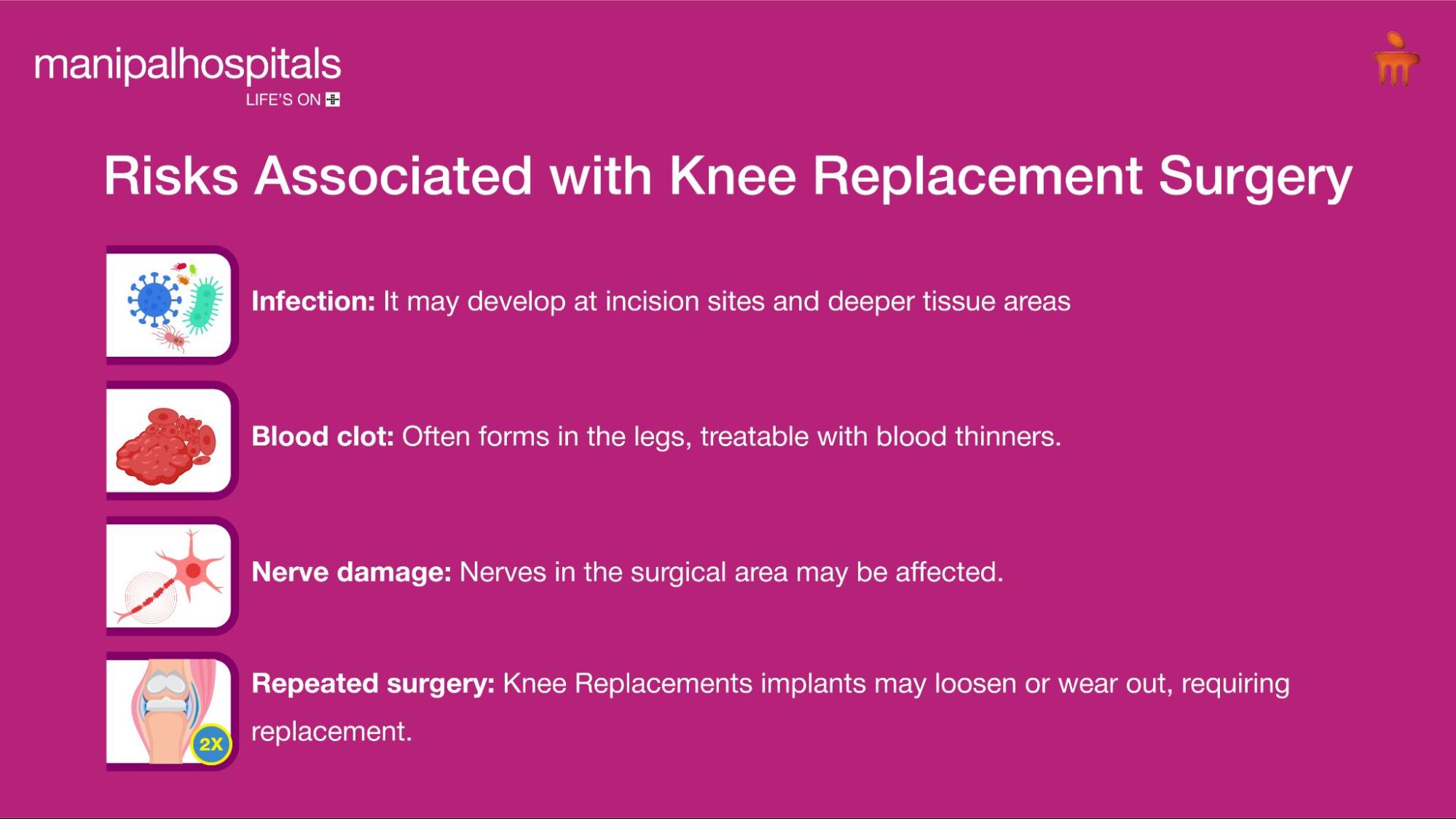Our knees bear a considerable amount of pressure and stress every day as they carry our weight. The knees naturally acquire ailments over time, particularly as we age. Various surgical options are available currently to treat knee-related issues or injuries. Among the procedures available, Knee Replacement and Arthroscopy Knee Surgery are among the most commonly performed procedures. Reportedly, 2 million Arthroscopy procedures are performed worldwide each year, while the number of Total Knee Replacements is expected to grow by 85% by 2030.
Which is better, Knee Replacement or Arthroscopy? Before selecting one of these processes, it is critical to grasp their relevance and fundamental distinctions. In this blog post, we explore the aspects related to these procedures so that you can make informed decisions regarding your surgical treatment.
Synopsis
- Understanding Knee Replacement
- Why Is Knee Replacement Surgery Performed?
- Risks Associated with Knee Replacement Surgery
- Understanding Arthroscopic Knee Surgery
- What Conditions Does Knee Arthroscopy Treat?
- Who Needs Arthroscopy?
- Knee Replacement vs. Knee Arthroscopy: Understanding Key Differences
- Conclusion
Understanding Knee Replacement
Knee Replacement is a surgical procedure used to replace components of damaged or worn-out knee joints. The operation attempts to enhance knee function and relieve pain. Partial Knee Replacement is performed when only a section of the knee is broken, whereas Complete Knee Replacement is done when the entire joint has to be replaced. During Total Knee Replacement, the surgeon will remove small parts of the thigh bone, shin bone, patella, and cartilage. Metal, plastic, or ceramic joints replace the removed knee.
Your healthcare provider will examine the knee’s range of motion, strength, and stability to determine your appropriateness for the procedure. An X-ray is used to determine the amount of damage. The surgical approach used and the type of prosthetics usually depend on the patient’s age, knee size and activity, weight, and overall health.
Why Is Knee Replacement Surgery Performed?
Knee Replacement Surgery is primarily performed to alleviate the pain caused by arthritis. Individuals dealing with difficulties in walking, getting up from a chair, climbing, or general activity due to arthritis are recommended to undergo the procedure. Other reasons to perform Knee Replacement Surgery include deterioration of the knee joint (avascular necrosis), knee injuries, or deformities.
Total Knee Replacement is recommended for serious knee injury or conditions like osteoarthritis and rheumatoid arthritis, where inflammation within the membranes can lead to pain and stiffness in joints. This type of surgery can help patients get back to their normal life by easing pain and making it easier to move around.
Risks Associated with Knee Replacement Surgery

Knee Replacement Surgeries pose certain risks like any other surgery, such as:
-
Infection: It may develop at incision sites and deeper tissue areas.
-
Blood clots: Blood-thinning medications treat blood clots, which typically develop in the legs. If clots spread to the lungs or brain, they can be life-threatening.
-
Nerve damage: Nerves in the surgical area can become damaged due to the procedure. Such damage often leads to numbness, pain, or even weakness.
-
Repeat surgery: Even though implants used in Knee Replacements are strong, they might become loose or worn out over time, necessitating the replacement of sections.
Understanding Arthroscopic Knee Surgery
A minimally invasive procedure that detects and cures a wide range of knee disorders. The surgery entails inserting a tiny camera into the knee via an incision. The camera projects the inside of the knee onto a screen in the operating room. Tiny instruments can be placed via the incision to treat, eliminate, or repair damaged knee concerns.
What Conditions Does Knee Arthroscopy Treat?
The following knee problems can be treated by Arthroscopy:
-
Soft tissue injuries: Injuries to tendons and ligaments within the joint, such as tears to the anterior cruciate ligaments, medial collateral ligaments, meniscus, or bursitis, can be treated with Arthroscopy.
-
Fractures: A broken or chipped-off bone or pieces of cartilage within the knee.
-
Inflammation: The procedure is carried out when the synovium (i.e., the tissue lining the joint, which helps in smooth joint movement) becomes inflamed.
Who Needs Arthroscopy?
Arthroscopy is primarily used to assess and treat disorders related to ligaments and cartilage within the knee joint. Arthroscopic knee Surgery is recommended when the patient has persistent knee pain that does not get better with non-surgical treatment. It is also advised when the patient is suffering from knee sepsis or infection to remove inflamed synovial tissue, trim out damaged articular cartilage, repair torn meniscus, reconstruct the anterior cruciate ligament, repair insatiable patella, and remove loosened bones and cartilage.
Knee Replacement vs. Knee Arthroscopy: Understanding Key Differences
|
Properties |
Knee Replacement |
Knee Arthroscopy |
|
Type of Procedure |
Major surgery, involves replacing the joint with implants |
Minimally invasive, uses small instruments and a camera |
|
Scope of Treatment |
Suitable for severe or advanced knee damage |
Best for mild to moderate knee issues (e.g., meniscus tear) |
|
Recovery Time |
Longer recovery period (weeks to months) |
Shorter recovery period (usually a few weeks) |
|
Cost |
Generally more expensive |
Less expensive than a Knee Replacement |
|
Post-Surgery Movement |
Some movement restrictions apply |
Typically, no long-term movement restrictions |
Conclusion
Understanding what to expect before and after Knee Replacement Surgery is essential for having a satisfactory outcome. Similarly, for less severe cases, Arthroscopy can be a faster and less invasive solution. When deciding between Knee Replacement and Arthroscopy, consult your orthopaedic physician. Speak with our qualified orthopaedicians at Manipal Hospitals, Broadway, to guide you on your treatment decisions.
FAQ's
You may be encouraged to opt for non-surgical options before attempting surgery, which include:
-
Physical therapy
-
Weight loss
-
Steroid injections
-
Anti-inflammatory medications
-
Hyaluronic injections
These treatments can relieve knee discomfort. However, surgery may be recommended if symptoms worsen.
Artificial knee implants are constructed of metal, ceramics, or a medical-grade plastic. They may be linked to the bone using bone cement, or their porous covering may allow the bone to grow on them.
Walking with the support of crutches or a walker is possible within the first few days. However, the type of surgery might affect the joint's capacity to bear weight.
You can climb stairs, but you should use the railing for support and proceed cautiously. Your doctor may provide guidance on when it is safe for you to climb stairs.
You can schedule an appointment at the Orthopaedics Department of Manipal Hospitals, Broadway, by contacting us or visiting our website.
Visit: https://www.manipalhospitals.com/broadway/specialities/orthopaedics/
Contact no: 033 6907 0001






















 6 Min Read
6 Min Read


















